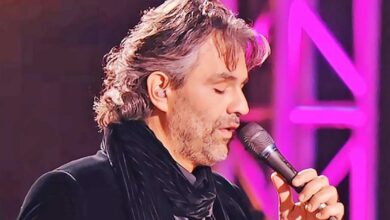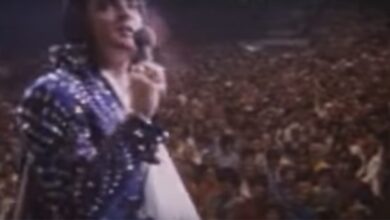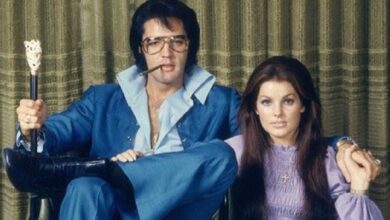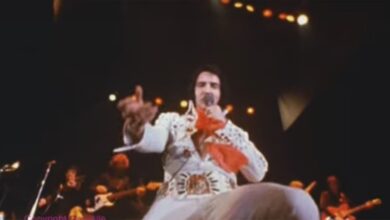Countless admirers insist he’s the greatest ever in this show, as he genuinely embodies the King of Rock and Roll
Elvis Presley’s performance of “Johnny B. Goode” during the landmark “Aloha from Hawaii” concert in 1973 stands as a defining moment in the annals of music and pop culture. This concert was not merely a musical performance; it was a monumental event that showcased the power of live entertainment on a global scale. Broadcast via satellite on January 14, 1973, it made history as the first concert to be transmitted live across the globe, reaching an estimated audience of over a billion viewers. Such unprecedented reach positioned Elvis not just as a popular entertainer, but as a cultural ambassador who transcended geographical and cultural boundaries.
The significance of the “Aloha from Hawaii” concert is further amplified by its elaborate production. Filmed at the Honolulu International Center, the concert featured a meticulously curated setlist that highlighted both Elvis’s classic hits and his ability to cover rock and roll standards. His performance of “Johnny B. Goode,” originally a staple of Chuck Berry’s repertoire, brought an exhilarating energy to the stage. With guitarist James Burton’s fiery solos and a tight rhythm section, the band provided a backdrop that allowed Elvis’s magnetic stage presence to shine.
Elvis’s choice to wear the now-iconic American Eagle jumpsuit during the concert was emblematic of his patriotism and his keen awareness of his global audience. The garment, which featured elaborate designs and a bold color scheme, has since become an enduring symbol of his persona. This visual statement, combined with the charged atmosphere of the concert, cemented Elvis’s image as the King of Rock and Roll, a title that encapsulated his influence over the genre and the broader music industry.
Before taking the stage, Elvis displayed a sense of nerves, a stark contrast to the confident performer that audiences had come to know. The sheer weight of the moment—a live satellite broadcast—was a new frontier for entertainers at the time. Yet, once the spotlight was on him, his anxiety melted away, and he delivered a performance that was electric and engaging. Each note he sang in “Johnny B. Goode” was imbued with his unique interpretation, blending his rock roots with the soulful delivery that made him a household name.
As the concert unfolded, it was clear that Elvis had successfully captured the hearts of millions, showcasing not just his vocal prowess, but his ability to connect with audiences emotionally. His renditions of other classics such as “Blue Suede Shoes” and “Hound Dog” received rapturous applause, yet it was “Johnny B. Goode” that illustrated his affinity for rock and roll. This performance highlighted a moment when Elvis, often cited as the bridge between different musical genres, paid homage to the pioneers of rock music while simultaneously affirming his place within that lineage.
The statistics surrounding the concert’s viewership are nothing short of staggering. In several countries, such as Japan and the Philippines, viewer engagement reached phenomenal levels, reflecting the universal appeal of Elvis’s music. The delayed broadcast in the United States on NBC garnered an astonishing 51% of the television audience, which speaks to the entertainer’s significance at that time, even surpassing pivotal events like the moon landing. Elvis’s outreach through this performance demonstrated the potential of media to connect disparate cultures through a shared love for music.
Elvis Presley’s impact on the landscape of music began in the early 1950s, with his blend of country, blues, and rock and roll paving the way for future artists. His dynamic approach to performance, characterized by his charisma and distinctive voice, catapulted him into the limelight quickly. Over the years, his repertoire of hits charted a course through the evolving musical landscape, influencing countless artists and genres along the way.
The legacy of “Aloha from Hawaii” continues to resonate, particularly as it encapsulated the dynamics of a cultural moment where music transcended mere entertainment. In the years since, Elvis’s influence extends beyond his own songs; he inspired a generation with his innovative use of technology and performance art, enriching the ways audiences experience live music. Even today, his mannerisms, style, and vocal techniques are emulated by aspiring performers aiming to capture the essence of his storied career.
In examining Elvis’s performance of “Johnny B. Goode,” one cannot overlook the critical role that collaboration played in achieving an outstanding musical performance. The synergy between Elvis and his band members brought a live energy that was palpable. The contribution of backup singers, including Kathy Westmoreland and The Sweet Inspirations, provided harmonic depth that elevated the performance to new heights.
The “Aloha from Hawaii” concert remains a testament to Elvis Presley’s legendary status, illustrating how music can be a powerful force for connection and unity. The echoes of his voice and the rhythms of his performances continue to inspire artists around the world, solidifying his position in the pantheon of musical greatness. Looking back at Elvis’s extraordinary life and career, it becomes clear that his artistic vision and innovative spirit have left an indelible mark on the history of music, forever altering the course of popular culture.
?si=BzOlf-lsX4MK__aC



